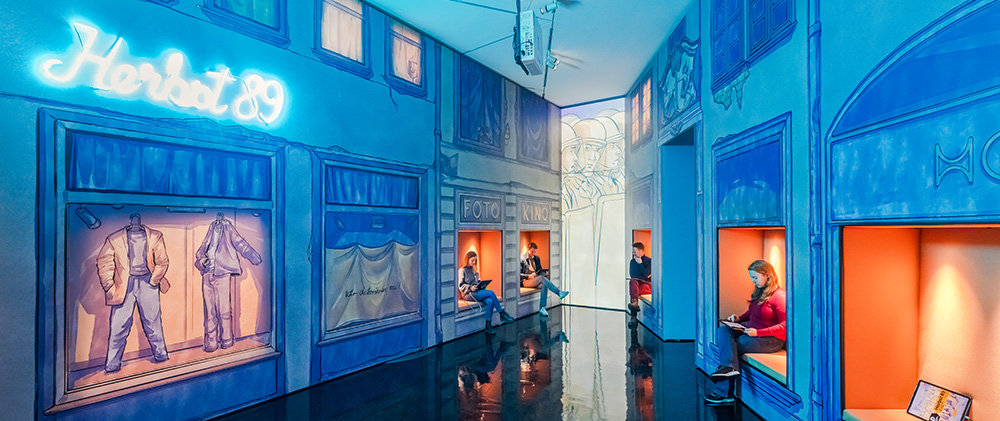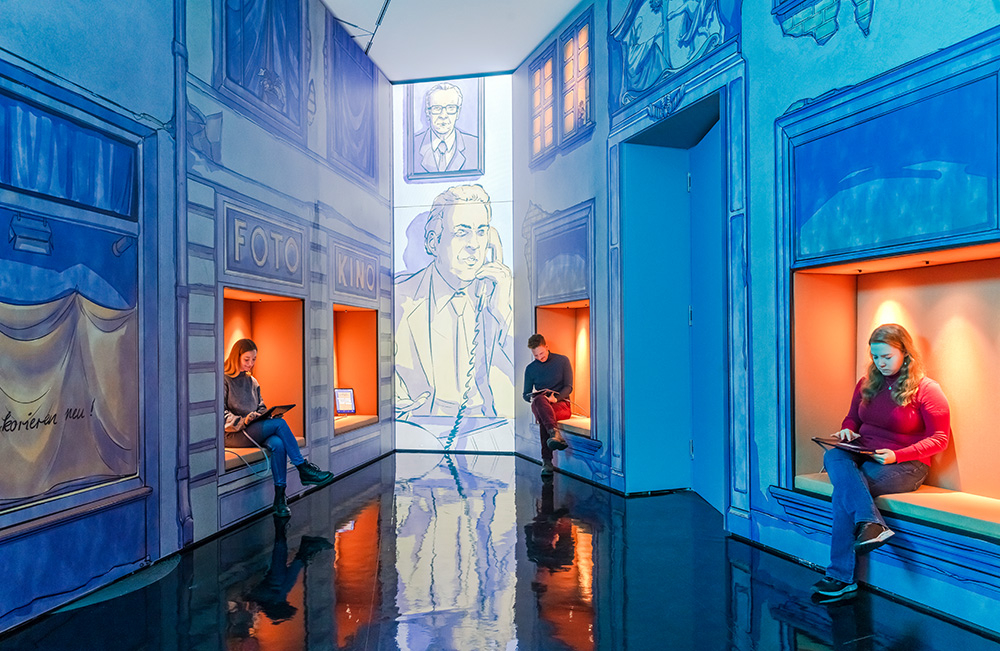
Game development in the museum: Game station “Autumn 89 – On the streets of Leipzig”
Elisabeth Breitkopf-Bruckschen | 25 January 2023
The interactive game station “Autumn 89 – On the streets of Leipzig” is located in the exhibition “Roads not Taken – Oder: Es hätte auch anders kommen können”. In this application, the events of 9 October 1989 in Leipzig can be followed by means of an interactive graphic novel, and the players can influence the outcome of that day by the choices they make. Project head Elisabeth Breitkopf-Bruckschen relates here how the DHM is finding new ways to communicate history through gamification.
9 October 1989: Anyone who took to the streets in Leipzig on that day to demonstrate for freedom and reforms risked a lot – perhaps even their life. The crowd of demonstrators faced a massive build-up of security guards. The fear of a “Chinese solution” filled the air. The GDR government had endorsed the crushing of the protests on the Square of Heavenly Peace in the summer of that year and left no doubt in anyone’s mind that they were ready to take drastic measures in their own country. No one could have imagined on this day that a month later, on 9 November 1989, the Berlin Wall would come down.
In its current exhibition “Roads not Taken – Oder: Es hätte auch anders kommen können”, the DHM demonstrates that history is an open process. History is marked by decisions and actions, but also by accidents of fate. DHM visitors can re-enact this experience in a very special way in the exhibition’s game station: they go through the day of 9 October 1989 by means of an interactive graphic novel and can determine what occurs and how it ends. Can they bring this day to a peaceful conclusion?
Players can choose to play one of seven different figures, including, for example, the civil rights activist Sabine or the policeman Thomas, who face each other on this day, and can experience the events from their respective perspectives. But there are also two historical figures who are ready to begin the day: Egon Krenz as a representative of the GDR government and Kurt Masur, the famous conductor who exerted his influence on this day by signing an appeal of the “Leipzig Six” for non-violence and dialogue. In the course of this history, the seven protagonists of the game have to make many decisions that will help to determine the outcome of the day.
The game station in the DHM is set in a special scene. The room contains two house facades in Leipzig, drawn by Alexander Roncaldier, who also illustrated the figures and the story of the interactive graphic novel. Visitors can sit in one of the five audio niches, follow the stories on tablets, and experience the acoustic background of the day by means of a specially designed sound track.

The earlier version of “Autumn 89 – On the streets of Leipzig”, which was developed together with the developer team “playing history” was first previewed for four weeks in March 2022 in the DHM’s Pei Building within the framework of the cooperative project “museum4punkto” under the title “Leipzig ’89 – Revolution reloaded”. The audience was invited to test this prototype extensively. More than 2,500 guests took up the invitation and gave the project team valuable tips for the further development of the graphic novel.
With the benefit of these results, the DHM project team worked together with “playing history” to expand the prototype into the full version that was then integrated into the exhibition “Roads not Taken”. The current version of the game represents a considerably more complex and interactive design. All of the storylines were extended and deepened. There are now not only more chapters and illustrations, but the drama of the historical moments of decision was intensified and concentrated. Completely new features were also added, such as animated sequences, mini-games, and the option of collecting historical finds, and the sound design was further integrated into the stories.
As the results show, it is a good idea to involve the public actively in the development of games and digital projects and to present the interim results that are then tested in order to offer the users a more attractive and lasting application.
“Autumn 89 – On the streets of Leipzig” can also be played online: www.dhm.de/herbst89. The application has been optically optimised for tablets and computers.
“Autumn 89 – On the streets of Leipzig” was developed within the framework of “dive in. Programme for Digital Interactions”, an initiative of the Federal Cultural Foundation, with the support of the Federal Government Commissioner for Culture and the Media in the programme NEUSTART KULTUR.

|
© DHM / Thomas Bruns |
Elisabeth Breitkopf-BruckschenElisabeth Breitkopf-Bruckschen has worked at the Deutsches Historisches Museum since 2011 as a research associate. Responsible to the office of the President of the Foundation, she carries out such duties as the committee work in the DHM and cooperation projects like the game station. Since 2019, she has been in charge of the development of the prototype of the game within the framework of the joint project with “museum4punkto” and the further development of the full version of “Autumn 89 – On the streets of Leipzig”, which was realised with the support of the subsidy programme “dive in” of the Cultural Foundation of the Federal Government. |
